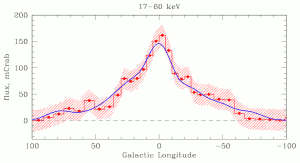 |
|
Fig. 1:
The map of the hard X-ray (17-60 keV) glow of the Milky Way obtained
by INTEGRAL (false color map image) very well agrees with the near
infrared image of the Galaxy (black countours). It strongly supports
the idea that the bulk of this glow emission is provided by weak
compact sources.
|
 |
 |
|
Fig. 2:
Brightness distribution of the Galactic ridge hard X-ray emission (red
dashed area) along the Galactic plane overplotted with the brightness
distribution of the Galaxy in near infrared spectral band (blue line).
|
|  |
Emission of our Galaxy in different spectral bands has very
different origin. For example, in near infrared, optical, and
ultraviolet spectral bands the Galactic emission is dominated by
stars. In hard gamma rays the Galactic emission is due to
interactions of high energy cosmic rays with the Galactic interstellar
matter (ISM). In X-ray and soft gamma ray energy bands the emission
of the Galaxy is dominated by some hundred bright compact sources
(accreting neutron stars and black holes). An additional weak X-ray
component was detected, which was not resolved into point sources in
existing observations. This glow was called the Galactic ridge X-ray
emission (GRXE), because it concentrates towards the Galactic plane
forming something like a ridge of X-ray glow.
Recently it was shown that there are good reasons to believe that the
GRXE (at least a dominant fraction of it) is due to a large number of
very weak X-ray sources — accreting white dwarf binaries and
coronally active stars (see e.g. the  research
highlight of march). The implication of this conclusion is a
definitive prediction of the shape of the ridge spectrum and the
spatial distribution of the GRXE. The spectrum of the ridge emission
should have an exponential cutoff at energies higher than ~20 keV,
which approximately corresponds to the proton binding energy of the
white dwarf. The spatial distribution of the GRXE should trace the
density of Galactic stars. research
highlight of march). The implication of this conclusion is a
definitive prediction of the shape of the ridge spectrum and the
spatial distribution of the GRXE. The spectrum of the ridge emission
should have an exponential cutoff at energies higher than ~20 keV,
which approximately corresponds to the proton binding energy of the
white dwarf. The spatial distribution of the GRXE should trace the
density of Galactic stars.
These predictions are now verified by a team of MPA astronomers using
the data of one of the most advanced hard X-ray imagers on orbit —
the IBIS telescope of the INTEGRAL observatory. Data collected by this
instrument over its 4 years of operation allowed them to map the weak
hard X-ray glow of the Galaxy and measure its spectrum. The map does
not correlate well with the Gamma-ray map of the Mikly Way, strongly
suggesting that X-ray emission in not generated by the cosmic rays
interaction with ISM. Instead the intensity of the GRXE in hard X-rays
traces well the stellar mass density distribution, thus providing
strong support to the idea that the bulk of GRXE is provided by weak
compact sources. In particular, for the considered 17-100 keV energy
band, the dominant contribution to the GRXE should come from
accreting white dwarf binaries. This result was further strengthened by the
detection of a high energy cutoff in the rigde spectrum.
At higher energies (200-500 keV) the diffuse emission of annihilating
positrons start to dominate over all other Galactic emission (see e.g.
the  research highlight of may 2005). At
even higher energies (>MeV) cosmic ray induced emission unambigousely
appears. research highlight of may 2005). At
even higher energies (>MeV) cosmic ray induced emission unambigousely
appears.
R.Krivonos, M.Revnivtsev, E. Churazov, S. Sazonov, S. Grebenev and R. Sunyaev
|



